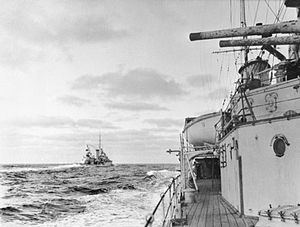| Battle of the River Plate | |||||||
|---|---|---|---|---|---|---|---|
| Part of the American Theatre of World War II | |||||||
 HMS Achilles as seen from HMS Ajax during the battle | |||||||
| |||||||
| Belligerents | |||||||
|
|
| ||||||
| Commanders and leaders | |||||||
|
|
| ||||||
| Strength | |||||||
|
Heavy cruiser Exeter Light cruiser Achilles Light cruiser Ajax | Panzerschiff Admiral Graf Spee | ||||||
| Casualties and losses | |||||||
|
72 killed 28 wounded Exeter heavily damaged Achilles moderately damaged Ajax moderately damaged |
36 killed 60 wounded Admiral Graf Spee critically damaged, later scuttled as a result | ||||||
The Battle of the River Plate was fought in the South Atlantic on 13 December 1939 as the first naval battle of the Second World War.[citation needed][clarification needed] The Kriegsmarine heavy cruiser Admiral Graf Spee, commanded by Captain Hans Langsdorff, engaged a Royal Navy squadron,[1][2] commanded by Commodore Henry Harwood,[3] comprising the light cruisers HMS Ajax, HMS Achilles (on loan to the New Zealand Division) and the heavy cruiser HMS Exeter.[4]
Graf Spee had sailed into the South Atlantic in August 1939, before the war began, and had begun commerce raiding after receiving the appropriate authorisation on 26 September 1939.[5] Harwood's squadron was one of several search groups sent in pursuit by the British Admiralty and sighted Graf Spee off the estuary of the River Plate (a.k.a. the Río de la Plata) near the coasts of Argentina and Uruguay.[6]
In the ensuing battle, Exeter was severely damaged and forced to retire, making for the Falklands; Ajax and Achilles suffered moderate damage. Damage to Graf Spee, although not extensive, was critical because her fuel system was crippled. Ajax and Achilles shadowed the German ship until she entered the port of Montevideo, the capital of neutral Uruguay, to effect urgent repairs. Langsdorff was told that his stay could not be extended beyond 72 hours. Apparently believing that the British had gathered a superior force to await his departure, he ordered for the ship to be scuttled.[7][8][9] Langsdorff would then commit suicide three days later.[10][11]
- ^ Gotta, César; Buzzi, Alfredo E. (1 January 2008). Surur, Alberto; Mariluis, Carolina; Daher, Cristián; Simonetto, Raúl; Re, Rodrigo; Kohan, Andrés (eds.). "Samuel Stuart Pennington y la Batalla del Río de la Plata. Segunda parte" (PDF). Revista Argentina de Radiología (in Spanish). 72 (1). Buenos Aires, Argentina: Sociedad Argentina de Radiología: 33–40. ISSN 0048-7619. Retrieved 28 August 2021 – via Redalyc.
- ^ Gotta, César; Buzzi, Alfredo E. (1 December 2007). Surur, Alberto; Mariluis, Carolina; Daher, Cristián; Simonetto, Raúl; Re, Rodrigo; Kohan, Andrés (eds.). "Samuel Stuart Pennington y la Batalla del Río de la Plata. Primera parte" (PDF). Revista Argentina de Radiología (in Spanish). 71 (4). Buenos Aires, Argentina: Sociedad Argentina de Radiología: 387–393. ISSN 0048-7619. Retrieved 28 August 2021 – via Redalyc.
- ^ Konstam 2016, pp. 17–20, 3. Opposing Commanders.
- ^ Konstam 2016, pp. 17–20, 4. Opposing Forces.
- ^ Hughes, Terry; Costello, John (1977). Wade, J.; MacVeagh, Lincoln (eds.). The Battle of the Atlantic. New York City: The Dial Press. ISBN 978-0-8037-6454-5. OCLC 464381083.
- ^ Grove 2013, pp. 1–56, I. The Chase and Destruction of the Graf Spee (including the Battle of the River Plate, 13 December 1939) – Plans 1, 2, 3, 4, 4A, 5 and 6.
- ^ Rust, Eric C. (1 October 2014). Bellamy, Martin (ed.). "Command Decisions: Langsdorff and the battle of the River Plate". The Mariner's Mirror. 99 (4). London, United Kingdom of Great Britain: Society for Nautical Research/Taylor & Francis: 492–494. doi:10.1080/00253359.2013.848587. ISSN 0025-3359. S2CID 110238416. Retrieved 27 August 2021.
- ^ Fischer, Diego (2015). Bonilla, Fernando (ed.). Tres hombres y una batalla: Historias desconocidas que rodearon a Millington-Drake y al Graf Spee (in Spanish) (3rd ed.). Montevideo, Uruguay: enguin Random House Grupo Editorial Uruguay. ISBN 978-9974-723-18-4. Retrieved 28 August 2021 – via Google Books.
- ^ Woodman, Richard; et al. (Graphics by John Morris and Christopher Summerville) (2008). The Battle of the River Plate: A Grand Delusion. Campaign Chronicles Series (2nd ed.). Barnsley, United Kingdom of Great Britain: Pen & Sword Books Limited. ISBN 978-1-4738-4573-2 – via Google Books.
- ^ Grove 2013, p. 1-56, I. The Chase and Destruction of the Graf Spee (including the Battle of the River Plate, 13 December 1939) – Plans 1, 2, 3, 4, 4A, 5 and 6.
- ^ Landsborough 2016, pp. 132–135, Chapter 24: Langsdorff's Death.